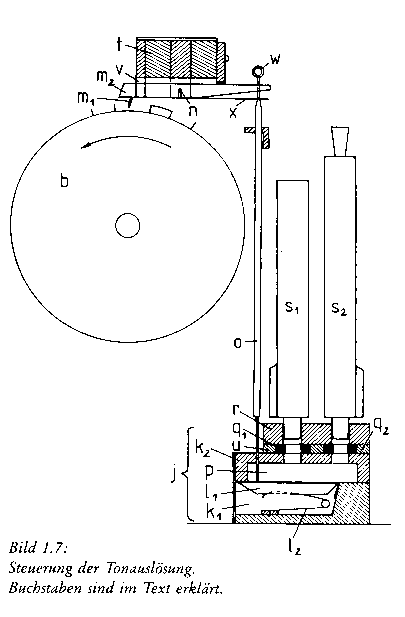| [1.3.2.3] Windlade
Nach Bild 1.5 steht der Magazin-Raum h1 über den Kanal i mit der
Windlade j in Verbindung und mündet in der Windkammer k1. Wie
auch in Bild 1.7 gezeigt, hegt in ihr unter dem Kanzellenbrett k2 das Spielventil
L1. Die Ventilfeder L2 drückt dieses nach oben. |
[1.3.2.3] wind chest
In picture 1.5 the magazine-area h1 lies over the canal i with the wind
chest j in connection and leading to the wind-chamber k1. As shown
also in picture 1.7, the play valve L1 nurtures in it under the Kanzellenbrett
k2. The valve spring L2 presses this upward. |
[1.3.2.3] somiere
Nella figura 1.5 il [mantice di] riserva h1 è situato sopra al
portavento i, connesso al somiere j, e porta il vento alla secreta k1.
Come mostrato anche nella figura 1.7, il ventilabro L1 si alimenta in essa
[cioé nella secreta] sotto al pancone k2. La molla L2 lo spinge
verso l'alto. |
Die Stifte der sich drehenden Stiftwalze heben über den Claviszahn
m1 den Arm der Clavis m2 an, die auf der Welle n sitzt.
(Clavis: weiblich, Einzahl: die Clavis, Mehrzahl: die Claves; deutscher
Ausdruck: Klavierhebel ) |
The pin of the turning pinned-cylinder lifts, via the key-tooth m1,
the arm of the Clavism2 that sits n on the axle.
(Clavis: female, singular: the Clavis, plural,: the Claves; German
expression: key-levers) |
La punta del cilindro chiodato che ruota solleva, per mezzo della punta
del tasto m1, la leva del tasto m2, che è incernierato sul perno.
|
| Sie liegt in einem Lager des in Bild 1.7 dargestellten Klavierholzes
t, auch Klavierbalken genannt. Damit senkt sich das gegenüberliegende
Ende der Clavis, und über den Stecher o wird das Spielventil L1 heruntergedrückt.
Es kann nun Wind über die Tonkanzelle p in die Pfeifen s1 und s2 strömen,
und die Pfeifen ertönen. |
Lying in the bed, picture 1.7, are the key-timers,
also called the key-beams. The opposite end of the
key is lowered with it, and via the sticker (o) the play valve L1 is
pushed down. It can now send the wind stream through the channel (p) into
the pipes (s1 & s2, and so the pipes sound.
|
Esso [il tasto] è collocato in un alloggiamento che nella figura
1.7 è rappresentato come "rastrelliera" (Klavierholzes) t, detta
anche "Klavierbalken". L'estremità opposta del tasto si abbassa
con esso, e sul pirone (asta) o, il ventilabro L1 viene spinto in basso.
Esso può ora mandare aria attraverso il canale p nelle canne s1
e s2, e così le canne suonano. |
| Die dargestellten Pfeifen gehören zwei verschiedenen Registern
an, hier ein Register mit offenen und ein weiteres mit gedeckten Pfeifen.
Zum Verändern der Klangfarbe läßt sich eines der beiden
Register auch abschalten (abwerfen). Dazu wird die Schleife q1 oder q2
verschoben, die zwischen dem Kanzellenbrett k2 und dem Pfeifenstock r liegt. |
The represented pipes belong to two different registers, here a register
with open pipes and another with stopped pipes. To the changing of the
tone color, one of the two registers can also be relaxed (shut off). To
do this the bow q1 or q2 is positioned, that lies between the whistle-stick
r and the Kanzellenbrett k2. |
Le canne rappresentate a ppa rtengono a due registri diversi, qui abbiamo
un registro di canne aperte ed un altro di canne tappate. Per cambiare
timbro, uno dei due registri può essere chiuso. Per fare questo
sono installate le stecche q1 e q2, che si trovano tra la coperta r e il
pancone k2.
|
| Wie in Bild 1.5 dargestellt, bestehen die Schleifen aus Lochleisten.
In der Betriebsstellung stimmen ihre Löcher mit den Bohrungen im Kanzellenbrett
und im Pfeifenstock genau überein, und der Wind kann von der Tonkanzelle
p zur Pfeife s1 bzw. s2 gelangen. |
As represented in picture 1.5, the stops consist of hole-strips. In
the operating position, its holes are right with the Bohrungens in the
Kanzellenbrett and in the whistle-stick exactly in agreement, and the wind
can reach the pipe from the Tonkanzelle p s1 as well as s2. |
Come mostra to nella figura 1.5, i registri consistono di stecche forate.
In posizione di lavoro, i loro fori sono allineati esattamente con i fori
corrispondenti del pancone e della secreta, e il vento dal canale p può
raggiungere la canna s1 così come la canna s2.
|
| Durch Verschieben der Schleife läßt sich der zwischen den
Schleifenlöchern jeweils liegende Steg in den Windweg zur Pfeife einschieben,
und alle Pfeifen des Registers verstummen. Als seitliche Führung für
die Schleifen dienen nach Bild 1.7 die Dämme u. |
Through closing of the stop, the bridge in each case lying between
the stop holes can be inserted into the wind-way to the pipe, and all pipes
of the register fall silent. As lateral guidance for the stops, picture
1.7 shows the dams u.
|
Chiudendo il registro, [cioè facendo scorrere la stecca],
i "ponti" tra i fori si interpongono nel condotto dell'aria verso
le canne, e tutte le canne del registro sono silenziate. Come guida
laterale per le stecche, la figura 1.7 mostra le false stecche u
|
| Die Claves werden vorn durch den Klavierrechen v geführt. Die
Stellschraube w und das Stellblech x ermöglichen das exakte und spielfreie
Einstellen der Verbindung zwischen Clavis und Spielventil. |
The keys are supported in front by the key frame v. The adjusting
screw w and the flat spring x enable the exact and free-playing of the
connection between the key and the play valve. |
I tasti sono sostenuti frontalmente dal telaio v. La vite di regolazione
w e la molla piatta x consentono l'esattezza e la libertà di movimento
del collegamento fra il tasto e il ventilabro. |
|
|
|
 Tech
Tech
 BarrelPiano
BarrelPiano
 Juettemann_1_2_3
Juettemann_1_2_3
